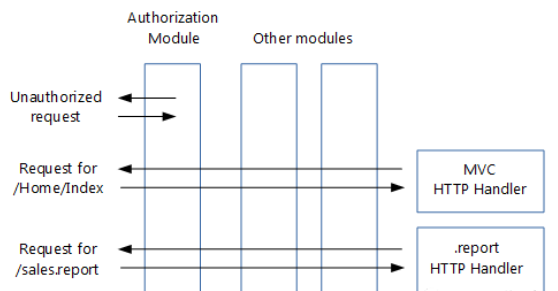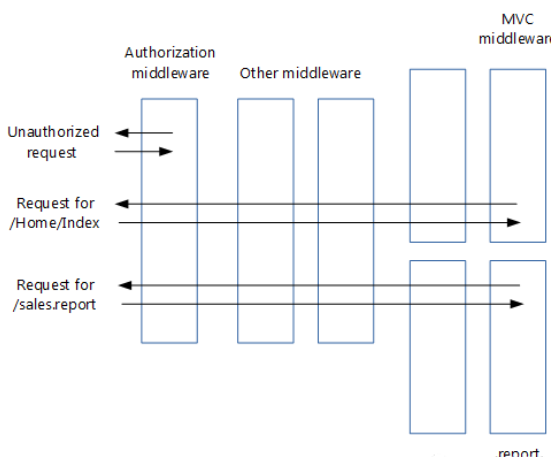您好,登錄后才能下訂單哦!
您好,登錄后才能下訂單哦!
.NET Core開發中Middleware的實踐是怎樣的,很多新手對此不是很清楚,為了幫助大家解決這個難題,下面小編將為大家詳細講解,有這方面需求的人可以來學習下,希望你能有所收獲。
熟悉ASP.NET架構的開發者一定對于HTTP Modules與HTTP Handlers不陌生。兩者的作用主要是對網絡請求執行特定的處理工作。而在.NET Core中,它們都被Middleware(中件間)取代了。
之前的Http Modules和HTTP Handlers是如下圖般處理請求的:

現在變成了這樣:

一言概括之,Middleware完成了HTTP Modules與HTTP Handlers的原有工作,但又不是簡單的化二為一的減法作用。
Middleware減去的其實是與原來ASP.NET中重要的基礎——應用程序生命周期事件(application life cycle event)的綁定。
HTTP Modules在初始化時就需要針對HttpApplication的事件作綁定處理,這樣當HttpApplication的各項事件被觸發時,已綁定的相應處理程序才會按照預期的那樣被執行。
public class HelloWorldModule : IHttpModule{ public HelloWorldModule() {
} public String ModuleName
{ get { return "HelloWorldModule"; }
} // In the Init function, register for HttpApplication
// events by adding your handlers.
public void Init(HttpApplication application) {
application.BeginRequest +=
(new EventHandler(this.Application_BeginRequest));
application.EndRequest +=
(new EventHandler(this.Application_EndRequest));
} private void Application_BeginRequest(Object source,
EventArgs e) { // Create HttpApplication and HttpContext objects to access
// request and response properties.
HttpApplication application = (HttpApplication)source;
HttpContext context = application.Context;
context.Response.Write("<h2><font color=red>
HelloWorldModule: Beginning of Request
</font></h2><hr>");
} private void Application_EndRequest(Object source, EventArgs e) {
HttpApplication application = (HttpApplication)source;
HttpContext context = application.Context;
context.Response.Write("<hr><h2><font color=red>
HelloWorldModule: End of Request</font></h2>");
} public void Dispose() {
}
}<configuration> <system.web> <httpModules> <add name="HelloWorldModule" type="HelloWorldModule"/> </httpModules> </system.web></configuration>
如果是用Middleware的話,事情就變得很簡單了。拋棄IHttpModule接口及HttpModule實現類,不用再關心HttpApplication的任何事件,還有煩人的web.config配置。直接在代碼中以最簡潔的方式完成工作。
public void Configure(IApplicationBuilder app, IHostingEnvironment env){
app.Use(async(context, next) =>{
await context.Response.WriteAsync("Beginning of Request\n");
await next.Invoke();
await context.Response.WriteAsync("End of Request\n");
});
app.Run(async (context) =>
{ await context.Response.WriteAsync("Hello World!\n");
});
}
相似的,對于HTTP Handlers,雖然不用取消對HttpApplication事件的依賴,但以兩者的代碼實現方式作比較,Middleware亳無疑問勝出一籌。
public class HelloWorldHandler : IHttpHandler{
public HelloWorldHandler() {
}
public void ProcessRequest(HttpContext context) {
HttpRequest Request = context.Request;
HttpResponse Response = context.Response; // This handler is called whenever a file ending
// in .sample is requested. A file with that extension
// does not need to exist.
Response.Write("<html>");
Response.Write("<body>");
Response.Write("<h2>Hello from a synchronous custom HTTP handler.</h2>");
Response.Write("</body>");
Response.Write("</html>");
}
public bool IsReusable
{ // To enable pooling, return true here.
// This keeps the handler in memory.
get { return false; }
}
}仍需要在web.config文件中注冊HTTP handler。
<configuration> <system.web> <httpHandlers> <add verb="*" path="*.sample" type="HelloWorldHandler"/> </httpHandlers> </system.web></configuration>
換作Middleware的寫法:
private static void HandleSample(IApplicationBuilder app){
app.Run(async context =>
{ await context.Response.WriteAsync("Hello Sample");
});
}
// This method gets called by the runtime. Use this method to configure the HTTP request pipeline.
public void Configure(IApplicationBuilder app, IHostingEnvironment env){
app.MapWhen(context => context.Request.Path.Value.EndsWith("sample"), HandleSample);
}
使用Middleware的優點:
沒有對HttpApplication的依賴
沒有對IHttpModule與IHttpHandler接口的依賴
無需在web.config文件中添加各種配置
代碼簡潔
最后需要補充Middleware與HTTP Modules的一點差異。各Middleware中處理請求與響應的順序是剛好相反的,越早處理請求的Middleware越晚處理響應。而HTTP Modules中處理請求與響應的順序則保持一致,因為每個HTTP Module請求與響應事件的綁定都是在同一階段完成的。
看完上述內容是否對您有幫助呢?如果還想對相關知識有進一步的了解或閱讀更多相關文章,請關注億速云行業資訊頻道,感謝您對億速云的支持。
免責聲明:本站發布的內容(圖片、視頻和文字)以原創、轉載和分享為主,文章觀點不代表本網站立場,如果涉及侵權請聯系站長郵箱:is@yisu.com進行舉報,并提供相關證據,一經查實,將立刻刪除涉嫌侵權內容。